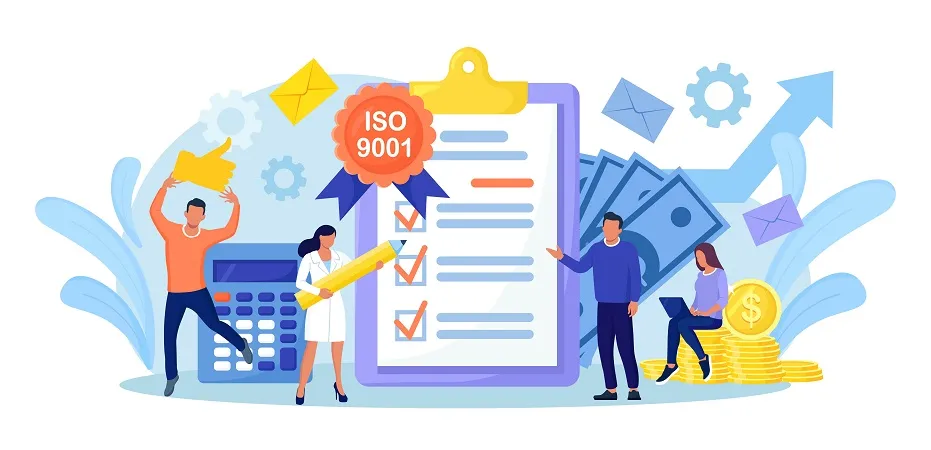Introduction to ISO 9001:2015 Standard
What is ISO 9001 Standard all about?
ISO 9001 became world recognised standard in 1987 after International Organization for Standardization formally published the international guidelines and qualifications required for organisation’s certification.
ISO 9001 provides opportunities to increase customer satisfaction, document corrective and preventive actions and of course standardisation. The organisational interest for implementing ISO 9001 standard is rapid return on investment and improvement in business. Regulatory requirements and import rules also dictate and require ISO 9001 certification that makes the need more than important.
What ISO 9001 Standard really does?
As a process owner and stakeholder, you may think of how ISO 9001 dictates documentation of processes, interactions, sequence and criteria of effectiveness. ISO 9001 is focused on the plan-do-check-act cycle that enables the process owners to control the processes, monitor results and review them periodically. The need to review the performance and feedback on process health is covered in internal audits which can the weakness and risks in the processes to recommend areas for improvement or non-conformities.
How to accomplish from ISO 9001 Documentation?
The documentation for key procedures and record keeping of corrective and preventive actions helps the organisation to improve. The corrective and preventive actions are usually taken to improve the existing condition and proactively address customer issues before their occurrence. Any customer complaint or non-conformity will need corrective actions to investigate root causes and addressing them. This will enable the process owners to study the root causes and eliminate the re-occurrence. Monitoring and measuring customer satisfaction will give areas of improvements and give an opportunity to improve. Customers also get a chance to communicate and provide areas of focus. Customer surveys gives an opportunity to collect data and analysis for making decisions.
Cost reduction through ISO 9001
ISO 9001 based QMS is the vehicle to drive the quality costs lower and specification variation. If you use preventive maintenance to maintain the capability of machines and measurement tools to hold close tolerance, you can eliminate inspection operations. To provide conformity to the requirements, calibration records, protecting equipment from damage and performing calibrations at regular intervals must be ensured. ISO 9001’s requirement for design review and product development plans enables the output to comply with the characteristics of the product and evaluate the ability to meet customer and design requirements.
What’s inside ISO 9001:2015?
The latest edition of ISO 9001 contains the following content as main clauses. Each clause has sub-clauses within that further explains the objective of each clause through intended actions and recommendations.
- Scope
- Normative references
- Terms and definitions
- Context of the organisation
- Leadership
- Planning
- Support
- Operation
- Performance evaluation
- Improvement
What do you need to do to be ISO 9001:2015 Certified?
Implementation of ISO 9001:2015 in your organisation is simple and easy of you take it as a project and manage the scope. Understanding the standard and requirements is the first thing to do and it should start from management and trickle down to each worker.
So, firstly obtain the copy of ISO 9001:2015 standard from www.iso.org and make your team familiar with the requirements. The easy way to bring commitment and adapting to change is arrangement of ISO 9001:2015 training through a reputable and experienced training agency. The registrar of ISO 9001:2015, often the third part auditor is accredited to carry out training and certification services. The training will help to familiarise with basic requirements and also focus on risk-management which is the key element in the standard. Internal Quality Auditing training is also key element and the person assigned for Internal Quality
Audits should be having the attributes and skills for doing this in the ideal manner. Next comes the gap analysis activity of your existing system. If you have no such concept of keeping procedures for each activity and things happen on expert’s individual ways and without any documented information or record keeping, start planning and brainstorm ideas from each process owner. Carry out independent activity that can identify gaps in existing quality management system and the ISO 9001:2015 requirements. A checklist may be suitable for this activity to standardise the outputs. Plan your project wisely and discuss with registrar (often the Third-party Auditor) to determine the timeline and scope. If your organisation is planning the certification for first time, the process should be given a trial run for at least three months and collect records.
After developing the QMS (i.e. developing policies, process flows, work inductions/ instructions, forms, record keeping etc.) review the performance of QMS and ensure its regular reporting. Internal Quality Audits must be performed, and corrective actions should be taken to address the issues in long run. A risk register and regular risk assessment should be available as well to meet key requirements of ISO 9001:2015. The registrar or accredited ISO 9001 Auditor should be contact once all the preparations are complete and the QMS is performing up to the requirements
Financial Effects of ISO 9001 Certifications
ISO certified companies reap the following benefits financially:
- Consistency of services
- Improved product performance
- Customer satisfaction improves
- Customer perception improves
- Improvement in productivity and efficiency
- Cost reductions
- Improved communications
- Better employee morale and job satisfaction
- Competitive advantage over other businesses
- Increased marketing and sales
Effect of Management Commitment
ISO 9001 has introduced several improvements regarding top management commitment. The clause on leadership and commitment includes some requirements designed for top management involvement and commitment. It is a fact that QMS implementation fails without commitment from top management. It is essential for Top management to demonstrate leadership and commitment by:
- Taking responsibility of the QMS effectiveness.
- Develop the quality policy and quality objectives and ensure their compatibility with Quality management system, organisation context and business strategy.
- Making sure that the quality policy is communicated, understood and implemented. Online Inductions by Induct For Work will assist your organisation with promoting the use of the process approach and risk-based thinking.
- Provide the necessary resources for quality management system implementation like tools, staff, resources and budget.
- Address the importance of quality management requirements to the staff and engage, direct and support the staff to help in improvement and effectiveness of quality management system.
- Monitor and control the objectives of quality management system and achieve the intended results.
- Supporting the management roles to establish their control and the areas of responsibility.
The element of customer focus is driven by management strong commitment to ISO 9001 objectives and helping improve the customer satisfaction and customer perception. They need to consider customer, statutory and regulatory requirements and consider the risks and opportunities that can affect product conformity to focus on enhance the customer satisfaction is always maintained and monitored.
ISO 9001 implementation in Small & Medium-Sized Organisations
Small and medium-sized organisations having significant problems during the planning and the implementation of a quality management system based on ISO 9001:2015. The foremost critical problems worry the organisation are documentation, the deficiency of ISO 9001 familiarity and understanding, the lack of time and resources, top management commitment and sense of ownership. These difficulties are more obvious in small companies with the problems of productive time that relates to financial and resources constraints. It is understandable that small organisations are not in the situation to dedicate a reasonable number of employees on ISO 9001 implementation project and they cannot absorb the cost of QMS preparation, development and ISO 9001 audits.
Most of the small organisations are not even meeting half of ISO 9001 requirements. Top management have no earlier experience in the implementation process of QMS. Lack of ISO 9001 experience and knowledge becomes dominant obstacle for the organisation to achieve. This can be handled by conducting both internal and exterior training. Internal training can be carried out by managers and any quality consultant as awareness sessions and team talks. The understanding developed by day-to-day process of upgrading and improving processes and procedures impacts the cultural change. Furthermore, measuring results and sharing performance using visual management can also help in team awareness.
The development of work instructions as one-page flow charts or video display is a good way to attract workers on understanding and following the process. The record keeping in form of paperwork is challenging if there has been no previous inspection concept and review of product.
The planning process also plays a vital role in QMS implementation and address many problems that may arise with development of QMS. The organisation due to its small size cannot isolate employees or departments to take the responsibility of quality activities. Therefore, the responsibility of QMS and other quality responsibilities can be taken up by the managers or the team leaders. As the resources are limited to hire a quality consultant or dedicated quality resource for quality activities, the organisation should carefully define the scope and smartly perform the mapping of ISO 9001 requirements to its operations. This may affect the speed of implementation and effectiveness but considering the limited budget and revenue of the small sized organisations, it is a good way to start.
ISO 9001 Certification Process
The final milestone for an organisation that is ready to apply for the certification by a third-party certification body, there are couple of stages to go through; Stage 1 and Stage 2 qualification. During Stage 1, the third-party certification registrar reviews all documentation to ensure that it is aligned with ISO 9001 requirements. If there are any faults or short comings, then a suitable time period is given to improve and review.
Stage 1 will not involve actual implementation of quality management system and can be done as a desktop audit, going through the documented information only and not checking the records and audit trail.
The next part of the certification process is Stage 2 during which the third-party certification registrar must see if the organisation has made required changes and improvements made in Stage 1.
The Stage 2 is concerned with checking the implementation of a quality management system and ensure that what the documented information is proved through records practically. If there is conformance to ISO 9001 requirements, then the organisation is awarded the certification. In case there is a still a need to comply with requirements, then more time is given to comply with the changes and fixing the issues and taking corrective actions. The certification is not awarded until the organisation has not made the necessary improvements.
After the organisation is ISO 9001 certified, there are periodic the surveillance audits on annual basis and re-certification process in the third year. This means that there are two surveillance audits in the next two years of initial certification and at the end of the three years after the initial certification, a comprehensive re-certification audit. Surveillance audits are done by the third-party certification registrar to ensure that QMS meets ISO 9001 requirements and plan-do-check-act cycle is in place.
Do you have any questions or great tips to share?
Induct for Work – the only online induction system you would need to run online inductions.



